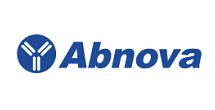ACTN1 & CTNNA1 Protein Protein Interaction Antibody Pair



* The price is valid only in USA. Please select country.
-
More Files
- More Functions
-
Specification
Product Description
This protein protein interaction antibody pair set comes with two antibodies to detect the protein-protein interaction, one against the ACTN1 protein, and the other against the CTNNA1 protein for use in in situ Proximity Ligation Assay. See Publication Reference below.

Reactivity
Human
Quality Control Testing
Protein protein interaction immunofluorescence result.
Representative image of Proximity Ligation Assay of protein-protein interactions between ACTN1 and CTNNA1. HeLa cells were stained with anti-ACTN1 rabbit purified polyclonal antibody 1:1200 and anti-CTNNA1 mouse monoclonal antibody 1:50. Each red dot represents the detection of protein-protein interaction complex. The images were analyzed using an optimized freeware (BlobFinder) download from The Centre for Image Analysis at Uppsala University.
Supplied Product
Antibody pair set content:
1. ACTN1 rabbit purified polyclonal antibody (100 ug)
2. CTNNA1 mouse monoclonal antibody (40 ug)
*Reagents are sufficient for at least 30-50 assays using recommended protocols.Storage Instruction
Store reagents of the antibody pair set at -20°C or lower. Please aliquot to avoid repeated freeze thaw cycle. Reagents should be returned to -20°C storage immediately after use.
-
Applications
In situ Proximity Ligation Assay (Cell)
-
Gene Info — ACTN1
Entrez GeneID
87Gene Name
ACTN1
Gene Alias
FLJ40884
Gene Description
actinin, alpha 1
Omim ID
102575Gene Ontology
HyperlinkGene Summary
Alpha actinins belong to the spectrin gene superfamily which represents a diverse group of cytoskeletal proteins, including the alpha and beta spectrins and dystrophins. Alpha actinin is an actin-binding protein with multiple roles in different cell types. In nonmuscle cells, the cytoskeletal isoform is found along microfilament bundles and adherens-type junctions, where it is involved in binding actin to the membrane. In contrast, skeletal, cardiac, and smooth muscle isoforms are localized to the Z-disc and analogous dense bodies, where they help anchor the myofibrillar actin filaments. This gene encodes a nonmuscle, cytoskeletal, alpha actinin isoform and maps to the same site as the structurally similar erythroid beta spectrin gene. Three transcript variants encoding different isoforms have been found for this gene. [provided by RefSeq
Other Designations
F-actin cross-linking protein|actinin 1 smooth muscle|alpha-actinin 1
-
Gene Info — CTNNA1
Entrez GeneID
1495Gene Name
CTNNA1
Gene Alias
CAP102, FLJ36832
Gene Description
catenin (cadherin-associated protein), alpha 1, 102kDa
Omim ID
116805Gene Ontology
HyperlinkGene Summary
alpha 1
Other Designations
alpha-E-catenin|alpha-catenin|alphaE-catenin|cadherin-associated protein,102kDa|catenin (cadherin-associated protein), alpha 1 (102kD)|catenin, alpha 1
-
Interactome
-
Pathway
-
Disease
- +1-909-264-1399
+1-909-992-0619
Toll Free : +1-877-853-6098 - +1-909-992-3401
- sales@abnova.com













